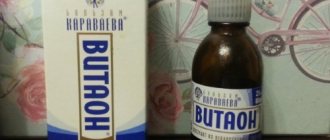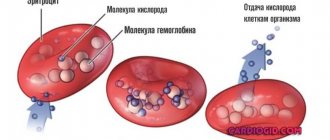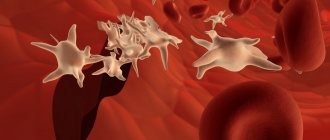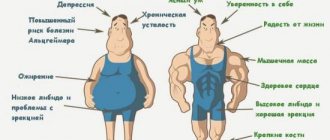A runny nose is an extremely unpleasant condition that usually goes away within 2 weeks. But sometimes a person complains of a stuffy nose and difficulty breathing through the nose in the absence of other signs characteristic of a “classic” runny nose.
This condition requires timely diagnosis and the appointment of adequate treatment, because it may indicate the presence of an allergic reaction, low-grade inflammatory processes, tumors and deformations of the nasal bones and cartilage, and other disorders. These defects and diseases require correction and treatment, because problems with nasal breathing can cause diseases of other organs.
Forms of congestion
A condition during which the nose is stuffy without snot cannot be called pleasant - constant swelling of the mucous tissue causes breathing problems, and this symptom can already provoke more serious problems.
These include decreased performance, concentration and attention, fatigue, inability to get a full night's sleep - a person feels tired, remembers necessary information worse and cannot concentrate on work and household responsibilities.
This happens due to oxygen starvation of the brain caused by insufficient ventilation of the lungs. Breathing through the mouth does not help the situation, since it does not create sufficient pressure in the pulmonary alveoli and oxygen is less absorbed into the blood.
Nasal congestion without snot is accompanied by the same symptoms as ordinary rhinitis, with the exception of mucous discharge from the nose:
- dryness, burning and itching in the nasal passages;
- constant sneezing;
- headaches, dizziness;
- lacrimation;
- discomfort in the soft tissues of the face.
The forms of dry nasal congestion can also be different:
- Constant (chronic).
The state of constant stuffiness without a runny nose is one of the most unpleasant for a person, since even regular blowing of the nose does not bring relief. In most cases, symptoms last up to several months in a row until the patient finally consults a doctor for examination and identification of the causes of the disease. Provoking factors here may be a curvature of the bony septum, polypous growths in the nasal passages and sinuses, pathologies of the endocrine system, and chronic vasomotor rhinitis.
- Frequent.
The frequency with which nasal congestion occurs directly depends on the provoking factor. Periods of exacerbation are usually followed by phases of stable remission, which is why the patient may suffer from periodic congestion for a long time and not consult a doctor - this picture is typical for allergic rhinitis and chronic sinusitis.
- Night.
Dry nasal congestion, which appears exclusively at night, which causes maximum discomfort to a person. It can be caused by both physiological and pathological reasons. Occurs mainly with sluggish inflammation of the nasopharynx and postnasal drip syndrome.
- Morning.
If your nose is stuffy only in the morning, and no mucous discharge is observed, it makes sense to undergo an examination to identify the causes of this condition. Factors that cause morning congestion can range from allergies to bedding material or down pillows to sinusitis (inflammation of the paranasal sinuses).
Since a long-term condition when the nose is stuffy and there is no snot is a sign of a chronic pathology occurring in the body, each patient is recommended to seek medical help as soon as possible.
What to do if your nose is stuffy
When your nose is constantly stuffy, what to do depends, first of all, on the diagnosis and age. Therefore, first of all, you need to determine the cause of this condition and only then take action.
Humidify the air
Even if the baby has a very stuffy nose and crusts appear in the nose, active air humidification will help. Of course, provided that the child is not sick. To ensure high-quality humidification, you can purchase a special household humidifier. If this is not possible, it is necessary to ventilate the room as often as possible. And also hang a wet cloth on the heating radiator, periodically moistening it.
Contact a doctor
A completely natural answer to the question of what to do if you have nasal congestion is to go see a doctor. A therapist or otolaryngologist will help you understand the cause of this condition. This will eliminate the need to use medications uncontrollably.
Use vasoconstrictor drops
For those who urgently need to get in shape, vasoconstrictor drops will help, which narrow the capillaries in the mucous membrane. As a result, swelling decreases and airway patency normalizes. However, such drops cannot be used independently for a long time. If your nose is stuffy during pregnancy, it’s better to ask your doctor what to do, rather than using the drops that you have on hand.
Physiological reasons
Dry nasal congestion is not necessarily a sign of a dangerous chronic disease, since in some cases it has physiological (transient and not dangerous to health) causes.
These include:
- Insufficient air humidity in the room. If the air is dry, this especially often happens in winter, with intensive operation of heating devices, the level of relative humidity can drop to 35-40%, which negatively affects the condition of the nasal epithelium. The mucous membrane becomes dry and thin, which forces the body to turn on protective mechanisms to moisten it independently - goblet cells secrete a certain amount of mucus (this causes swelling of the epithelium and a feeling of nasal congestion).
- Poor nutrition. If a person abuses fatty foods, eats a lot of flour and sweets, especially with increased body weight, there is excess sugar in the blood. As a result of hormonal imbalance, swelling of the nasal epithelium appears and, as a result, the nose partially stops breathing.
- Side effect from taking medications. If a patient is undergoing long-term treatment for any chronic disease, and especially if it is accompanied by the use of systemic nasal medications, dry nasal congestion may be a side effect. Typically, this condition goes away on its own after completion of therapy and does not require treatment.
- Insufficient blood circulation in the head and neck area. It can be observed if a person rarely spends time in the fresh air, eats poorly, smokes too much and abuses alcohol. Usually, to normalize the condition, it is enough to adjust your lifestyle, walk more often, give up bad habits and play sports.
Unexpected nasal congestion in a healthy person can be caused by hypothermia.
Coming in from the cold, a person may feel an accumulation of mucus in the nose, which is caused by a sharp narrowing of blood vessels. This condition can last throughout the night, but in the morning the non-breathing nose goes away.
What to do if you breathe too dry air. Ways to moisturize the mucous membrane
Dry air contributes to the thinning of the mucous membrane and a decrease in its protective properties.
There are effective methods to help moisturize it:
| Name | Description |
| Warming up | Use salt or eggs. You can warm up your nose with special devices (salt heating pads). Eggs are boiled and applied to the nose. The salt is heated in a frying pan and placed in a fabric bag. Apply to the wings of the nose. |
| Washing | Use regular or sea salt. For 1 liter of water you will need 1 tsp. salt. The nose is washed using a special device or a rubber bulb. It is recommended to consult a doctor about how to carry out the procedure. Without experience and knowledge, there is a risk of worsening your health condition. |
| Drops | You can moisten the nasal mucosa with special drops (saline, Kalanchoe, aloe juice). Ready-made or freshly prepared solutions are instilled into the nose 3 times. per day. 2-3 drops are enough in each nostril. |
| Inhalations | The procedures are carried out using a special device (nebulizer, inhaler). Saline solution, chamomile or sage decoction, and essential oils are used as a solution. |
Drinking plenty of fluids helps remove toxins from the body and moisturize the nasal mucosa. It is recommended to consume more tea, compotes, fruit drinks, and decoctions prepared with herbs.
Pathological causes
In addition to physiological causes that do not pose a threat to human health, there are various pathologies, including those of a chronic nature, that can provoke prolonged dry nasal congestion.
What happens in the nose?
Immune cells are produced by the thymus (thymus gland) and they move throughout the body with the blood and lymph flow.
If bacteria or viruses begin to multiply in the nose, the response of our defense system is very simple: the body dilates blood vessels, which increases the flow of blood to the site of inflammation, and along with the blood, the influx of immune cells. This is how the fight against pathogenic microorganisms begins.
The nasal mucosa is penetrated by a huge number of capillaries. Due to their expansion and swelling, the mucous membrane becomes thicker and partially or completely blocks the nasal canal - this is why the nose becomes stuffy without a runny nose.
This protection algorithm is most noticeable at the initial stage of the disease, when mucus has not yet been produced, and the immune response has already started.
In the chronic course of the disease, this cycle is repeated again and again, since it is not always possible to completely destroy pathogenic microorganisms only by the forces of one’s immunity (without treatment). As soon as its defenses weaken, bacteria begin to actively reproduce and a new immune response occurs.
Infectious diseases
The most common cause of difficulty in nasal breathing is considered to be a diffuse inflammatory process in the cavity of the paranasal sinuses - sinusitis or sinusitis.
When the sinuses are completely clogged with serous-purulent contents, the nasal mucosa becomes inflamed and swollen, blocking the anastomosis (openings connecting the sinuses to the nasal passages).
According to the nature of the process, the process can be:
- acute, with a clear clinical picture: headaches, fever and constant nasal congestion, without mucous discharge;
- chronic. The symptoms described above will be absent, and the stuffy nose will occur periodically when the immune system weakens. For example, due to hypothermia, when blood vessels narrow and blood flow slows down, which reduces the concentration of immune cells and gives bacteria a new chance to reproduce.
Another cause of an infectious nature is considered to be ozena - this is the so-called fetid runny nose, caused by the proliferation of pathogenic bacteria in the nasal cavity. In this case, the mucus rarely flows out, forming dried crusts in the nasal passages with a pungent unpleasant odor.
The cause of a stuffy nose without a runny nose is often caused by bacterial infections of the larynx. If a person has an inflamed throat as a result of tonsillitis, pharyngitis, laryngitis, these diseases can provoke swelling of the tissues of the nasopharynx, while no mucous discharge from the nose is observed.
Allergic reactions
The second most common cause of long-term nasal congestion diagnosed in patients is allergies. It can be caused by various factors - pollen from flowering plants, house and book dust, synthetic material from which bed linen is made, fur from pets living at home, the smell of flowers, food, household chemicals, medications and other irritants.
The reason why a stuffy nose at night can be caused by mold spores that are found in places not visible to the human eye - under the floor, on the walls and ceiling. Even cigarette smoke, if someone in the house smokes, can cause watery eyes, sneezing and nasal congestion without snot. To confirm this diagnosis, you must undergo an allergen test from an allergist.
Postnasal drip syndrome
The signs of this syndrome are especially pronounced in the morning - it is difficult for a person to breathe through the nose, since in a horizontal position of the body the mucus flows poorly and blocks the choanae (internal openings of the nose); he feels a lump in the throat, and is bothered by a dry, irritating cough. Postnasal drip (postnasal drip syndrome) occurs as a consequence of inflammatory processes in the upper respiratory tract.
In this case, mucous and purulent discharge from the nasal passages and sinuses accumulate on the posterior laryngeal wall during night sleep, and the person is not aware of the presence of snot.
This manifestation is especially typical in otitis media (inflammation of the middle ear), when mucus from the Eustachian tube flows directly into the larynx, bypassing the nose. And with ethmoiditis (inflammation in the cells of the ethmoid labyrinth), due to their anatomical location, mucus flows not into the nasal cavity, but into the throat.
In addition to nighttime nasal congestion, an adult patient may be bothered by headaches (signs of intoxication due to purulent sinus lesions), fever, redness of the posterior laryngeal wall, and general weakness.
Drip syndrome is dangerous because the flowing mucous secretions in large quantities enter the stomach, which can cause digestive system upset.
Neoplasms in the nasopharynx
The growth of polyps and adenoids in the nasopharynx cavity can also cause the nose to not breathe, but there is no snot. Adenoids are enlarged tonsils that grow due to chronic upper respiratory tract infections. Their growth is due to frequent colds, decreased immunity, and disturbances in the functioning of the lymphatic system.
Polyposis is dangerous because nasal mucus, not finding a way out, stagnates and accumulates in the sinuses, forming an excellent environment for the development of pathogenic flora. The result is inflammation of the paranasal sinuses (sinusitis, sphenoiditis, ethmoiditis).
Polyps are a slightly different disease. These growths are benign formations that can appear on the surface of the epithelium of the nasal passages and sinuses due to frequent sinusitis and disorders of the immune system.
Thus, the mucous membrane tries to compensate for lost functions by thickening the connective epithelium. The pathology is always accompanied by impaired olfactory function, nasal congestion (partial or complete), sneezing, headaches and the appearance of a nasal voice.
Diagnostics
In order to choose the most appropriate method of treating nasal congestion, it is necessary to undergo a comprehensive examination to determine the true cause of the unpleasant syndrome.
The diagnostic procedure includes the following steps:
- Examination by an ENT doctor, asking the patient about how long ago the symptom appeared and its nature - congestion can be one or two-sided, appear periodically or be a constant concern. The doctor will also clarify whether the person suffers from chronic diseases, what is being treated, and whether there is an effect from the therapy.
- Examination of the nose using a rhinoscope. During the procedure, defects of the nasal septum, swelling of the epithelium, and the presence of mucous discharge are detected.
- Carrying out endoscopy. Allows you to examine the nasopharynx in more detail, identify symptoms of sinus inflammation, see tumors and anatomical defects.
- Computer or magnetic resonance imaging. Allows you to establish the exact localization of polypous growths, their size and nature.
An alternative to MRI and CT can be radiography of the nasal cavity in two projections, this makes it possible to identify sinusitis, polyps and adenoids. If the allergic nature of the syndrome is suspected, consultation with an allergist is required.
Indications for surgical intervention for chronic nasal congestion without runny nose
In the absence of a positive result after using medications and folk remedies, patients are advised to undergo surgery.
| Name | Description |
| Polyectomy | The procedure is prescribed to remove polyps in the nose. |
| Adenoidectomy | An operation during which the adenoids are removed. In children, laser treatment is preferably used. |
| Septoplasty | Helps eliminate anatomical problems and deviated nasal septum. |
| Conchotomy | Prescribed to patients with tumors in the nasal concha. |
| Vasotomy | The operation helps eliminate chronic vasomotor rhinitis. |
Children are allowed to undergo surgery strictly after reaching 4 years of age. Before the operation, a thorough diagnosis is carried out, prescribed by an otolaryngologist.
Nasal congestion is not always a consequence of a dangerous disease. But impaired breathing brings great discomfort to a person, disrupting sleep and wakefulness. The reasons may be different; an otolaryngologist will help determine the source of the problems. Congestion without a runny nose requires timely diagnosis and treatment to prevent serious complications.
Article design: Oleg Lozinsky
Drug treatment
Treatment of nasal congestion without snot is carried out only after diagnosis, because each of the provoking factors requires its own individual therapy.
The allergic nature of congestion is treated as follows:
- the patient is prescribed antihistamines - Zyrtec, Claritin, Suprastin, Tavegil;
- the use of systemic sprays containing hormonal or antihistamines is indicated - Flixonase, Nasobek, Rinofluimucil, Vibrocil, Isofra, Polydexa;
- It is recommended to limit contact with irritants (substances or factors that cause an allergic reaction, be it medications, dust, wool, food or pollen).
All these measures are selected individually, after skin tests are carried out to identify the type of irritant.
If congestion occurs due to acute or chronic inflammation of the paranasal sinuses, first of all, the patient is indicated for treatment with antibiotics. The doctor selects medications taking into account the type of pathogen and its resistance to medications (for this, a nasal swab is taken). Most often, drugs from the groups of cephalosporins, penicillins or macrolides are used.
To reduce the level of swelling and inflammation, the patient is advised to take antihistamines and systemic sprays with anti-inflammatory and vasoconstrictor effects - Protargol, Isofra, Polydexa, Bioparox, Rinofluimucil, Sinuforte.
Before introducing topical drugs into the nose, you should rinse with saline solution or an isotonic drug from the Dolphin or Marimer series. This will help to pre-wash mucus from the nasal passages and enhance the effectiveness of subsequent medications.
If there is a large amount of thick or purulent exudate, the patient is washed with a YAMIK catheter, washed with a Cuckoo or punctured the paranasal sinus, followed by treating it from the inside with an antiseptic solution.
After this, the patient can do the procedure at home using a soda-salt solution, a decoction of medicinal herbs or antiseptic drugs, for example, Furacilin.
Neoplasms in the nasopharynx, especially if they have reached their maximum size, can only be removed surgically - there are several methods for this, such as laser therapy, cryotherapy, removal of loops and other treatment methods.
To prevent the re-formation of polyps, the doctor prescribes local antibacterial treatment and internal administration of drugs from the group of immunomodulators.
Alternative medicine
Traditional medicine recipes can be used as a complement to the treatment prescribed by the doctor, but it is not recommended to use them as a method of monotherapy. Their effectiveness cannot be compared with synthetic medications, and the root cause of breathing problems cannot be cured. Homemade remedies can only relieve the symptom for a short period of time.
What non-traditional methods are the most effective:
- Aloe or Kalanchoe leaf juice. Aloe or Kalanchoe leaf juice. These plants are famous for their anti-inflammatory and antimicrobial properties; freshly squeezed juice from the leaves helps ease breathing, narrow the capillaries in the nose, stop the proliferation of pathogenic microbes and clear a clogged nose. It is necessary to squeeze out the juice, dilute it with water 1:3 and instill 3-4 drops several times a day.
- Garlic. This root vegetable contains a storehouse of phytoncides and beneficial substances that can fight harmful microorganisms. You need to take a clove of garlic, chop it and place it in a glass. Place the dishes in a water bath, then prepare a cardboard funnel. Cover the garlic with the wide side of the funnel, and inhale its vapor through the narrow side for about 5 minutes.
- Honey. This powerful anti-inflammatory remedy can help relieve long-term nasal congestion by making small cotton swabs, dipping them in fresh liquid honey and keeping them in your nose for about 15 minutes.
- Beetroot-carrot composition. You need to grate one medium-sized fruit at a time, squeeze out the resulting juice and instill a few drops three times a day. You can dilute it half and half with water.
- Plantain leaves. 1 tbsp. l. raw materials are poured with 250 ml of boiling water and allowed to brew. The composition, cooled to 35-38 degrees, is instilled into the nose for congestion caused by allergies or bacterial infections.
A good effect is achieved by inhaling the vapors of essential oils of eucalyptus, fir, pine, mint, and lavender. You can stir a few drops of your favorite essential oil in hot water and breathe over the steam for 10-15 minutes. You can do dry inhalation - apply a few drops to a handkerchief or napkin, place it on a table or bedside table and inhale the vapors.
Prevention
In order to prevent polyps from growing again and again, even after surgical interventions and not only, you need to follow a diet. Eating salty, spicy foods and coffee increases the growth of polyps. Sports and an active lifestyle eliminate physical inactivity, which also contributes to the proliferation of polyposis cells. Also useful:
- review your diet and eat right;
- take vitamins;
- compliance with hygiene rules and wet cleaning;
- create good ventilation of the premises, prevent the development of mold and fungi;
- do not overcool, observe a rest regime.
If the body often catches colds or is subject to inflammation, you need to contact an immunologist or otolaryngologist. Strengthening the immune system will prevent the emergence of new health problems not only of the nose.
Attentive attitude to colds, their prevention, elimination of vitamin deficiency will prevent neoplasms from developing. If you notice nasal congestion for no reason, examination and treatment should begin quickly.
Advanced nasal congestion can lead to complications in the form of chronic inflammation. This condition leads to sleep disturbance at night, snoring, which leads to fatigue and loss of performance. In children and adults, prolonged difficulty breathing can change the shape of the face. A person begins to breathe through his mouth all the time; such a face is even called adenoid. Paying attention to your health allows you to quickly and permanently get rid of breathing problems.
Possible complications
The list of possible unpleasant consequences includes atrophic changes in the nasal mucosa. When the tissue cannot fully perform its functions (clean and moisten the inhaled air), this leads to easy penetration of infections into the body through the nose. Due to atrophic runny nose, the nasopharynx becomes defenseless against the attack of viruses, allergens and bacteria, which affects the frequency of colds and allergic reactions.
The second complication is a pathological change in the structure of the nasal turbinates. To compensate for the lack of air and increased stress on the nostrils, the cavities become wider, sometimes surgical intervention is required to solve this problem.
A complication of persistent allergic rhinitis can be the development of bronchial asthma, which will not be easy to get rid of. Prolonged inflammation in the paranasal sinuses can provoke the development of meningitis, frequent sore throats, sinusitis and other inflammatory processes that become chronic over time.
Risk factors in children
In children, the causes of nasal congestion without a runny nose come down to the following:
- deformation of the nasal plate;
- polyps;
- adenoids;
- allergic reaction;
- foreign body.
Breathing problems in a baby under one year old can occur due to the physiological state of the mucous membrane. After birth, it is formed over 2-3 months. Mucus and increased dryness of the air in the room affect the development of crusts. Because of this, the baby’s breathing becomes difficult, he is capricious, refuses to eat and sleeps poorly.
Let's summarize
As you can see, nasal congestion, which arose seemingly for no apparent reason, can become an impetus for the development of serious complications and chronic bacterial infections. If your nose gets stuffy from time to time, but the feeling goes away after a couple of rinsing procedures or inhalations, there is no need to worry. You need to sound the alarm when the ability to breathe does not return for several weeks or months - this condition requires an urgent visit to an ENT doctor and examination.
Live healthy! Three tests for a stuffy nose. (03/09/2016)
Treatment of nasal congestion











